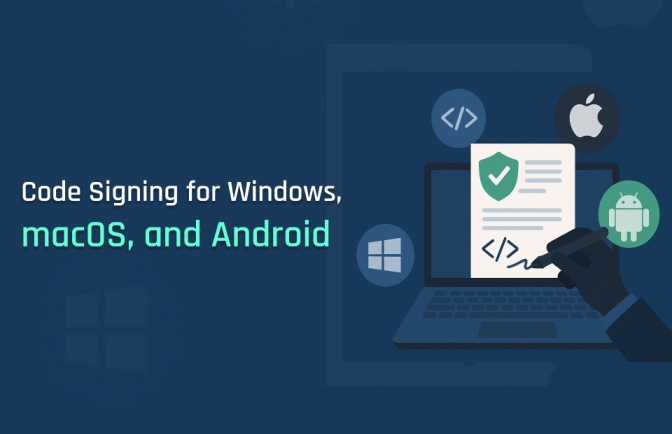


Learn how code signing works across Windows, macOS, and Android. Protect your software’s integrity on every major platform.
In today’s digital age, trust is currency and nowhere is that more apparent than in software distribution. Whether you’re developing desktop applications for Windows, distributing a macOS utility, or pushing Android apps to the Play Store, one element remains constant: the need to verify your identity and ensure that your code hasn’t been tampered with. That’s where code signing comes into play.
Code signing is the process of digitally signing software using a certificate issued by a trusted Certificate Authority (CA). This signature acts like a digital seal, confirming the authenticity of the publisher and ensuring that the code hasn’t been altered since it was signed. The specific implementation and requirements, however, vary across different platforms.
Let’s explore how code signing functions across major platforms, Windows, macOS, Android, and more, and what developers should keep in mind when choosing the right signing method and certificate.
For Windows applications, particularly those distributed outside the Microsoft Store, code signing is almost mandatory. When users download unsigned software, Windows Defender SmartScreen may block the file, displaying an alarming warning that scares off non-technical users.
There are two primary types of certificates used:
Applications signed with EV certificates enjoy better initial trust, especially for new or low-distribution software. This is crucial for independent developers looking to establish credibility quickly.
Most developers use tools like Microsoft’s SignTool.exe to apply their digital signatures, integrating the signing process into their build pipelines.
For example, platforms like SignMyCode offer both standard and EV certificates tailored for Windows environments, helping developers streamline the code signing process while complying with Microsoft’s guidelines.
On macOS, Apple has introduced a multi-step security process that includes both code signing and notarization. Code signing alone is no longer sufficient, Apple now requires all applications distributed outside the Mac App Store to be notarized as well.
How It Works
This process ensures that Gatekeeper, Apple’s security layer, allows the app to run without showing warnings. Unsigned or non-notarized apps will trigger security blocks, requiring users to manually override system settings.
Unlike Windows, macOS developers cannot use certificates from third-party CAs. Only Apple-issued Developer ID certificates are permitted, and developers must enroll in the Apple Developer Program.
Android requires all apps to be digitally signed with a certificate before they can be installed. This signing ensures integrity and identifies the author of the application. Without a proper signature, Android will reject the APK outright.
As for Android 9 (Pie), APK Signature Scheme v2 is required, and newer versions support v3 and v4 for additional protection.
Google encourages developers to use Google Play App Signing, which manages your signing keys securely and offers better protection in case of key loss. Developers upload an unsigned APK, and Google applies the final signature.
While Android doesn’t rely on CAs like Windows or macOS, code signing remains an essential step, especially for developers outside the Play Store ecosystem or those distributing enterprise apps.
When selecting a code signing certificate, consider the platform and distribution method. For instance:
Affordable certificate providers and resellers have made access to code signing more feasible for independent developers and small teams. While platforms like SignMyCode offer streamlined access to certificates and automation tools, it’s essential to evaluate the broader ecosystem and your platform-specific requirements.
